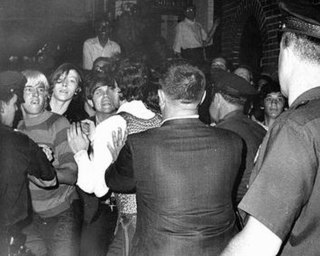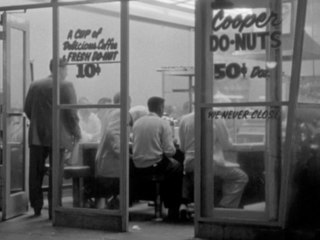
The Stonewall riots, also known as the Stonewall uprising, Stonewall rebellion, or simply Stonewall, were a series of protests by members of the LGBTQ community in response to a police raid that began in the early morning hours of June 28, 1969, at the Stonewall Inn in the Greenwich Village neighborhood of Lower Manhattan in New York City. Patrons of the Stonewall, other Village lesbian and gay bars, trans activists and unhoused LGBT individuals fought back when the police became violent. The riots are widely considered the watershed event that transformed the gay liberation movement and the twentieth-century fight for LGBT rights in the United States.

A gay bar is a drinking establishment that caters to an exclusively or predominantly lesbian, gay, bisexual, transgender or queer (LGBTQ+) clientele; the term gay is used as a broadly inclusive concept for LGBTQ+ communities.

The White Night riots were a series of violent events sparked by an announcement of a lenient sentencing of Dan White for the assassinations of George Moscone, the mayor of San Francisco, and of Harvey Milk, a member of the city's Board of Supervisors who was one of the first openly gay elected officials in the United States. The events took place on the night of May 21, 1979 in San Francisco. Earlier that day White had been convicted of voluntary manslaughter, the lightest possible conviction for his actions. The lesser conviction outraged the city's gay community, setting off the most violent reaction by gay Americans since the 1969 Stonewall riots in New York City.
Operation Soap was a raid by the Metropolitan Toronto Police against four gay bathhouses in Toronto, Ontario, Canada, which took place on February 5, 1981. Nearly three hundred men were arrested, the largest mass arrest in Canada since the 1970 October crisis, before the record was broken during the 2006 Stanley Cup Playoffs in Edmonton, Alberta.

Divers/Cité was an LGBT multidisciplinary arts and music festival taking place each year in the heart of Montreal, since 1993. A week-long avant-garde event in the heart of downtown Montreal and in Montreal's Gay Village area held usually on the end of July and beginning of August every year, it was open to all audiences, gay and heterosexual, including many free events.

The gay liberation movement was a social and political movement of the late 1960s through the mid-1980s in the Western world, that urged lesbians and gay men to engage in radical direct action, and to counter societal shame with gay pride. In the feminist spirit of the personal being political, the most basic form of activism was an emphasis on coming out to family, friends, and colleagues, and living life as an openly lesbian or gay person.

Lesbian, gay, bisexual, and transgender (LGBT) people in Belarus face significant challenges not experienced by non-LGBT residents. Although same-sex sexual activity is legal in Belarus, gay and lesbian rights in the country are otherwise severely limited and homosexuality remains highly stigmatized in Belarusian society. Households headed by same-sex couples are not eligible for the same legal protections available to opposite-sex couples. Belarus provides no anti-discrimination protections for LGBT people, nor does it prohibit hate crimes based on sexual orientation and gender identity. Many Belarusian people believe that homosexuality is a psychiatric illness, and many LGBT persons in Belarus tend to hide their sexual orientation in public. Those who are "out" face harassment, violence and physical abuse.

Gay Village is a neighbourhood delineated by Saint Catherine Street East and Atateken Street in the Ville-Marie borough of Montreal, Quebec, Canada.
The 1st World Outgames took place in Montréal, Quebec, Canada from July 26, 2006, to August 5, 2006. The international conference was held from July 26 to the 29. The sporting events were held from July 29 to August 5.
This is a timeline of notable events in the history of the lesbian, gay, bisexual and transgender (LGBT) community in Canada. For a broad overview of LGBT history in Canada see LGBT history in Canada.

The Black Cat Tavern is an LGBT historic site located in the Silver Lake neighborhood of Los Angeles, California. In 1967, it was the site of one of the first demonstrations in the United States protesting police brutality against LGBT people, preceding the Stonewall riots by over two years.

Helem is the first LGBTQIA+ rights non-governmental organization in the Arab world, founded in Beirut, Lebanon, in 2001. Its mission is to lead a non-violent struggle for the liberation of lesbian, gay, bisexual, transgender, queer, intersex, and other persons with non-conforming sexualities and/or gender identities (LGBTQIA+) in Lebanon and the MENA region from all sorts of violations of their individual and collective civil, political, economic, social, and cultural rights. Helem’s name was also an acronym in Arabic that stood for “Lebanese protection for the LGBT community”.
The Patch was an LGBT bar formerly located at 610 W. Pacific Coast Highway in the Los Angeles neighborhood of Wilmington, California. The Patch, along with the Black Cat Tavern, played a pivotal role in the gay rights movement, when, in August 1968, it was one of the first sites where there was open resistance to the constant police harassment of gay establishments and meeting places in Southern California.
This article gives a broad overview of lesbian, gay, bisexual and transgender (LGBT) history in Canada. LGBT activity was considered a crime from the colonial period in Canada until 1969, when Bill C-150 was passed into law. However, there is still discrimination despite anti-discrimination law. For a more detailed listing of individual incidents in Canadian LGBT history, see also Timeline of LGBT history in Canada.

The LGBT community in Liverpool, England is one of the largest in the United Kingdom and has a recorded history since the 18th century. Many historic LGBT firsts and pioneering moments in the LGBT rights movement either took place in Liverpool or were achieved by citizens of the city.

New York City has been described as the gay capital of the world and the central node of the LGBTQ+ sociopolitical ecosystem, and is home to one of the world's largest LGBTQ populations and the most prominent. Brian Silverman, the author of Frommer's New York City from $90 a Day, wrote the city has "one of the world's largest, loudest, and most powerful LGBT communities", and "Gay and lesbian culture is as much a part of New York's basic identity as yellow cabs, high-rise buildings, and Broadway theatre". LGBT travel guide Queer in the World states, "The fabulosity of Gay New York is unrivaled on Earth, and queer culture seeps into every corner of its five boroughs". LGBT advocate and entertainer Madonna stated metaphorically, "Anyways, not only is New York City the best place in the world because of the queer people here. Let me tell you something, if you can make it here, then you must be queer."

The Cooper Do-nuts Riot was an alleged uprising in reaction to police harassment of LGBT people at a 24-hour donut cafe in Los Angeles in the 1960s. Whether the riot actually happened, the date, location and whether or not the cafe was a branch of the Cooper chain are all disputed, and there is a lack of contemporary documentary evidence, with the Los Angeles Police Department (LAPD) stating that any records of such event would have been purged years ago.
This is a timeline of notable events in the history of the lesbian, gay, bisexual and trans community in Manchester.
On August 5, 1969, the Atlanta Police Department led a police raid on a screening of the film Lonesome Cowboys at a movie theater in Atlanta, Georgia, United States.
The Atlanta Eagle police raid was a police raid targeting the Atlanta Eagle, a gay bar in Atlanta, Georgia, United States. The raid occurred on September 10, 2009, due to anonymous tips alleging that illegal drug use and sex was occurring at the bar. Several dozen officers were involved in the raid, including members of the Atlanta Police Department's vice squad and the "Red Dog Unit", a SWAT-like unit typically used in high drug use areas. None of the 62 bar patrons that night were arrested, although eight employees were. Seven of these employees were either found not guilty or had charges dropped against them, while one was not present at the trials and had a bench warrant issued against him.












